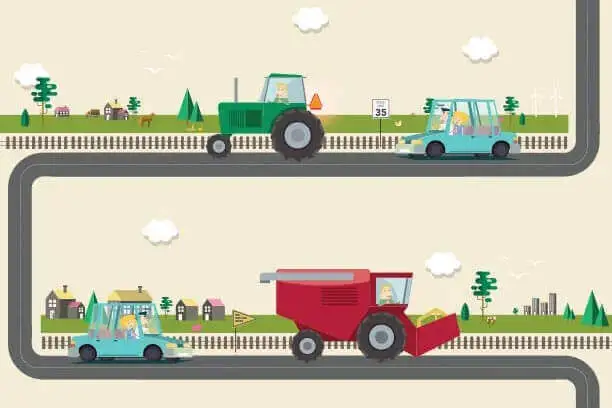5 Tips for Sharing the Road with Farm Equipment


Changes in the season also bring changes on the road. If you live or drive anywhere near a rural community, you’ll probably be seeing a lot more farm equipment out and about, including on the roadways. Learning to share the road with farm equipment is an essential part of driving safety. So, what’s the best way to share the road with farmers? Here are our top five tips to help keep you and farmers safe this season.
Slow-Moving Vehicle (SMV) signs are orange or red triangular signs that are placed on the back of farm equipment. This is your warning to slow down. Even if the farmer is driving farm equipment on a public road, don’t assume they are traveling the speed limit. Did you know it takes just five seconds for a car traveling 55 miles per hour to close a distance the size of a football field on a tractor or combine? When you’re sharing the road with farm equipment, keep a safe distance and always stay alert.
It’s easy to get impatient when you find yourself behind a slow-moving piece of farm equipment but resist the urge to pass illegally. That means following the same rules that would apply to other vehicles: never pass on curves or hills, when nearing intersections or at railroad crossings, bridges or tunnels.
Most farm equipment is huge compared to the average car, requiring the driver to make wide left turns. If farm equipment veers right, don’t take this as automatic permission to pass; check the cab for hand signals from the driver first. It’s not always safe for farmers to drive their equipment on the shoulder, so if they veer right, they could just be preparing for a left-hand turn.
When you do pass farm equipment on the road, be courteous and don’t just roar by. Air turbulence from a speeding vehicle can cause farm equipment to sway and become unsteady.
As you’re sharing the road with farmers, be aware of the distance needed to safely clear farm equipment when you drive by. You should also yield to wide vehicles on the opposite side of the road. Flashing lights or reflective tape are often used to mark the far right and left edges of the equipment, which may be wider than the road lanes.
For more information about road safety and how you can protect your vehicle — whether it’s a car or a combine — contact your Farm Bureau agent.
